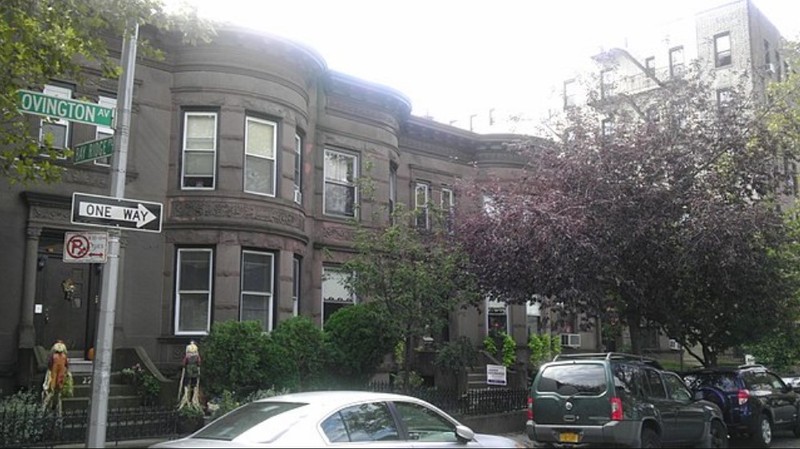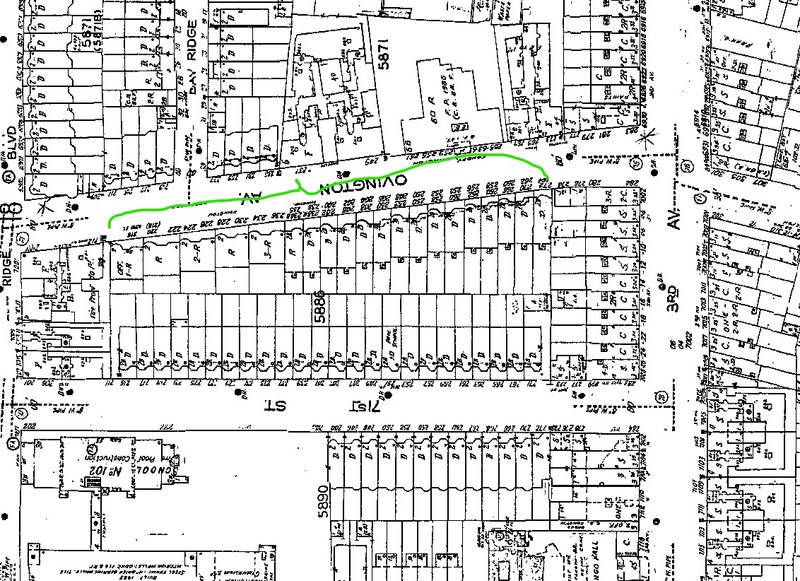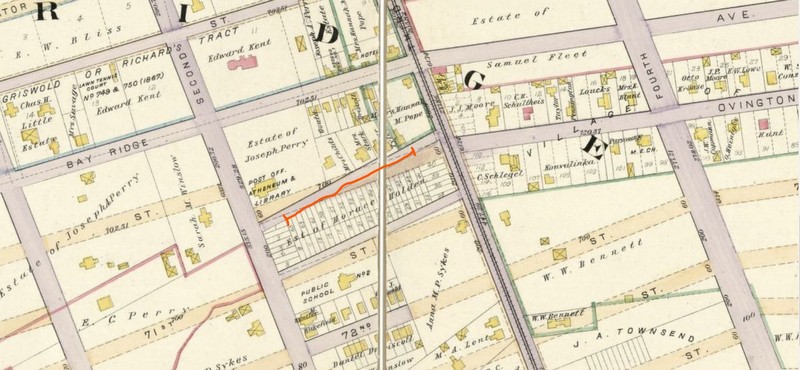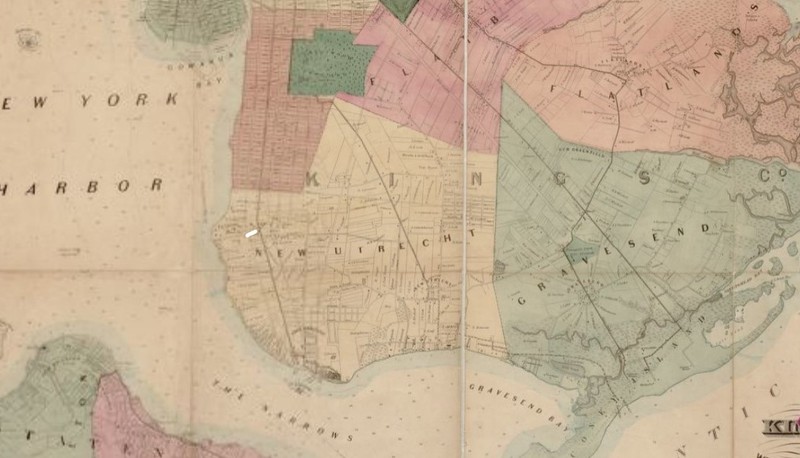Townhouses at 216-264 Ovington Ave.
Introduction
Text-to-speech Audio
The brownstone townhouses from 216 to 264 Ovington Ave. in the Bay Ridge section of Brooklyn were built from 1908 to 1910 by real estate developers. The townhouses, on the south side of Ovington Ave. west of Third Ave., are one of only two blocks of intact historic townhouses in Bay Ridge (the others are along Senator St.) listed as historic districts in the National Register of Historic Places. The Neo-Renaissance style townhomes have bowed fronts and were constructed by the Silliman Construction Company in two standard designs. Fancy carved brownstone decorations include garlands, swags, foliage, and heraldic elements in panels below windows and above main entrance doors.
Images
2012 photo of some of the 216-264 Ovington Ave. townhouses (Jim.henderson)

216-264 Ovington Ave. townhouses (green bracket) on 1926 Sanborn map, updated to ca. 1986 (Correa and Pulaski 2007)


1872 map showing New Utrecht Township and vicinity; future townhouses (white line) (Dripps map of Kings County)

Backstory and Context
Text-to-speech Audio
Bay Ridge is in the western part of the former Dutch town of New Utrecht, founded in the 1650s. A village called Yellow Hook (hook is from the Dutch for "corner") developed near this part of New Utrecht, but its name was changed to Bay Ridge to avoid negative association with yellow fever disease. In the mid-nineteenth century, the waterfront and ridgetop land became the locale of mansions with a view of the bay. The Town of New Utrecht became part of the City of Brooklyn in 1894 and part of New York City in 1898.
By the end of the nineteenth century, as transportation improvements were made or being planned to connect Bay Ridge with other parts of the Boroughs of Brooklyn or Manhattan, real estate speculation became commonplace. One such project was the block where the twenty townhouses from 216 to 264 Ovington Ave. now stand. Before the townhouses were built, the south side of this block of Ovington Ave. was owned by the estate of Horace Holden (see the 1890 Robinson map below). The Holden land was subdivided into building lots but not developed.
The Neo-Renaissance style townhomes are monochrome (brown) with a variety of classical decorations, entrances framed in stone, and elaborate cornices. The five rowhouses built at the western end (216 to 234 Ovington) are wider than the other fifteen. The west townhouses also have a central entrance between projecting bays; the rest of the rowhouses have only 1 projecting bay next to the main entrance bay. While rows of brownstone townhouses are common in Brooklyn, they are rare in Bay Ridge. Besides this Ovington Ave. block, the only other grouping of brownstone rowhouses in Bay Ridge is along Senator St.; both blocks form National Register historic districts. "Brownstone" rowhouses were typically built of brick with an outer veneer of brownstone (a type of sandstone) several inches thick. Brownstone was soft enough to be cut using steam-powered tools, lowering its cost enough that the middle classes could afford stone houses. Nearby sources for the stone, in Connecticut and New Jersey, also brought down its cost. The homes' exteriors have been well-preserved over the last 110+ years.
One of the residents of these townhomes in 1915 was Bailey Quick, who lived at 258 Ovington Ave. Mr. Quick was a civil servant who had worked as a copyist for the Kings County Registers Office since 1902; his annual salary was $1,200. Quick and his wife were graduates of the Manual Training High School and were active in its alumni association in the 1900s - 1910s. A doctor named Charles R. Gill lived at 252 Ovington Ave. in 1917; formerly from Puerto Rico, Dr. Gill was a member of the Princeton University Class of 1881. Samuel Chandler resided at 236 Ovington Ave. in the early 1920s; he was a graduate of the University of Michigan Class of 1881 and had recently worked with the American Sugar Refining Company. Other early residents worked as carpenters, a ship captain, a teacher, or merchants.
Cite This Entry
Paonessa, Laurie. "Townhouses at 216-264 Ovington Ave.." Clio: Your Guide to History. April 14, 2022. Accessed April 7, 2025. https://theclio.com/entry/148423
Sources
Alumni Society of the University of Michigan. The Michigan Alumnus. Volume XXVIII. Ann Arbor, MI. Alumni Memorial Hall, 1922.
Anonymous. The Alumni. Princeton Alumni Weekly. March 21st 1917. 550 - 553.
Anonymous. "In the Social World." Standard Union (Brooklyn) November 26th 1909. 7-7.
Corea, Jeannette. Polaski, Susan. NRHP Nomination, Houses at 216-264 Ovington Avenue, Brooklyn, N.Y. National Register. Washington, DC. National Park Service, 2007.
State of New York Legislature. Documents of the Assembly of the State of New York 138th Session 1915. Volume XIX. No. 61 Part 1. Albany, NY. J.B. Lyon Company, 1915.
xx
New York State Cultural Resource Information System (NYS CRIS): https://cris.parks.gov/
Library of Congress (LOC): https://www.loc.gov/item/2011594778/
LOC: https://www.loc.gov/item/2006636779/

